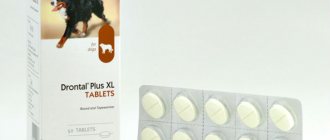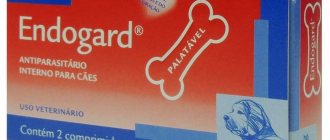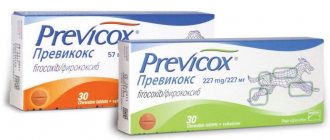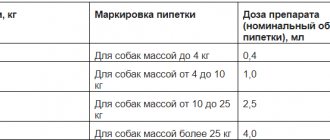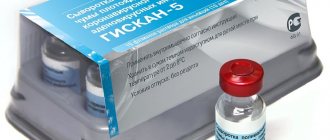Chondoprotector Artroglycan is often prescribed for the treatment of dogs with joint pathologies and simply for the prevention of diseases of the musculoskeletal system. The drug has a good composition, and its cost is in the middle price segment.
But still, with regular use, Artroglycan will cost a pretty penny. Reviews about the medicine are contradictory, so owners doubt whether it is worth buying the medicine.
Let's figure it out together: does Artroglycan help, how does it work, what are its pros and cons, and also what analogues can replace the drug.
Content
1. General description 2. Composition and action 3. Purpose 4. Dosage 5. Limitations 6. Price and analogues 7. Video: 8. Reviews
Increased stress on the joints, excess weight, dietary errors that lack important nutritional components and minerals - all this leads to the development of arthritis in pets and other problems with the musculoskeletal system. Artroglycan for dogs is a feed additive that is used to restore cartilage.
Contraindications and side effects
As long as the dosages are observed, negative reactions are usually not observed. Rarely, allergy symptoms may occur in dogs with hypersensitivity. They will manifest themselves as itching, skin hyperemia, disruption of the gastrointestinal tract (loose stools, nausea). In these cases, the drug is replaced with an analogue. It is forbidden to give drugs to:
- simultaneously with other chondoprotectors;
- if you are allergic to the active ingredients;
- if joint diseases were caused or complicated by an infection: viral, bacterial or fungal.
Composition and action
Dogs
– active animals, but in the process of motor activity the load on their bones increases. As a result, over time the cartilage wears away. As soon as the layer becomes very thin, the bones will begin to wear away. The rubbing of bones against each other is accompanied by severe pain.
Chondroprotectors will help restore the integrity of cartilage tissue. Artroglycan contains the same components as drugs used to treat arthritis:
- chondroitin sulfate. It slows down the destruction of bones and cartilage tissue by blocking enzymes that cause destructive processes, reduces calcium loss, and has an analgesic effect;
- glucosamine hydrochloride. Strengthens cartilage, stimulates the synthesis of intra-compound fluid;
- Selenomethionine is a naturally occurring amino acid containing selenium. It accelerates the rate of absorption of chondroitin and glucosamine, slows down the aging of tissues, and maintains their elasticity;
- calcium gluconate, vitamin E - normalize metabolic processes in tissues and have a beneficial effect on the entire animal’s body.
In combination, the components of Arthroglycan maintain the integrity of cartilage and promote their restoration.
Important! Artroglycan is not a medicine, but a feed additive; it will not eliminate the problem that caused the degenerative processes, but will only alleviate the animal’s condition.
How it works
Artroglycan has 3 main actions. He:
- relieves inflammation;
- reduces joint pain;
- slows down the destructive processes of cartilage and joint tissue.
In general, the drug helps to improve the condition of the musculoskeletal system and normalize the metabolic processes of the osteoarticular system. The drug also partially restores damaged cartilage tissue.
Additional elements - vitamin E and selenomethionine - normalize blood flow and microcirculation in the capillaries. At the same time, they improve the functioning of the heart and liver. When taking Arthroglycan regularly, dogs stop limping and whining due to joint pain, and they are no longer stiff in their movements. Thanks to this, they become active again, enjoy walking outside and playing.
Purpose
Artroglycan is prescribed for chronic pathologies of the musculoskeletal system. Most often they affect large breed animals that experience increased stress on their joints. In addition, with age, joints begin to deteriorate and cartilage tissue depletes in all animals, regardless of breed and size.
Dog owners should be alert if:
- the pet often licks joints;
- whines;
- slowly, as if with effort, he climbs the stairs;
- does not show activity during walks;
- limps, etc.
Often, owners do not immediately pay attention to changes in the pet’s behavior and well-being, so they show the dog to a veterinarian only when degenerative changes have already begun. However, Artroglycan is not recommended for use for prevention: it contains substances that can cause side effects, so the feed additive should be used only as prescribed by a veterinarian as a component of complex therapy.
Indications for use of the drug are:
- arthritis and ostearthrosis;
- arthrosis;
- osteoporosis;
- spondylosis;
- intervertebral osteochondrosis;
- joint dysplasia and other pathologies of the locomotor system.
Important! For preventive purposes, veterinarians sometimes recommend using a food additive for older dogs, overweight animals, pregnant females, and puppies during the period of teeth change.
Arthritis
is an inflammatory disease that begins in the synovial membrane and affects the joint and neighboring organs and tissues, and sometimes the entire body. It is manifested by a general deterioration in the animal’s condition, an increase in temperature, refusal of food, etc. The joint tissues swell, local hyperthermia can be noted.
Follow us
Find out more about your animal's personality on our social networks
If the joints begin to deteriorate, osteoarthritis develops. Complex therapy will help stop the process and restore mobility. Without treatment, the prognosis is disappointing: paralysis, amputation, and possible death.
Arthrosis is a pathological change in the joints associated with damage to cartilage tissue. Various factors can provoke a chronic disease:
- injuries;
- inflammatory processes;
- infectious diseases;
- stressful situations.
When cartilage tissue does not fully perform its protective function, bones rub against each other and the joint capsule loses its elasticity. Every movement causes pain to the pet. This leads to limited movement and an increased risk of further injury.
The drug is not able to grow damaged cartilage, but it:
- slows down the progression of destructive processes;
- accelerates the recovery process after joint surgery;
- relieves pain.
Clinical studies and observations of animals have shown that positive dynamics become noticeable after 6-8 weeks of treatment with the drug.
Arthroglycan analogues
Price: 30 tablets ─ 280 rub., 300 tablets. ─ 2165 rub.
In terms of composition and principle of action, Artroglycan is comparable to the following analogues:
- Kanvit Hondro;
- ArthroFos Forte;
- Stride Plus;
- AktiVet;
- Chondrocan.
Kanvit Chondro has a similar composition. The manufacturer under this name produces a line of chondroprotectors for different breeds. Additionally contains niacinamide, biotin and magnesium chelate. The cost of the drug depends on the volume of the package and the variety, ranging from 380 to 1900 rubles.
In addition to cholesterol and HA, ArthroPhos Forte is enriched with L-carnitine, tocopherol, ascorbic acid, and selenium. Contains minerals necessary to maintain healthy bone tissue. The price of a 700 g jar is 2,600 rubles.
The dietary supplement Stride Plus, in addition to chondroitin and glucosamine, contains hyaluronic acid and sulfur. It is considered one of the most effective chondroprotectors today. The cost of the drug depends on the release form (powder or suspension) and volume. A 0.5 kg jar costs 3,700 rubles, a 500 ml suspension costs 4,700 rubles.
In addition to components that have a chondroprotective effect, AktiVet contains MSM (a source of sulfur), ascorbic acid and Boswellia extract, which has an analgesic effect. The package contains 90 tablets, the cost of which is 910 rubles.
The components of Chondrocan are collagen, chondroitin, glucosamine, minerals (calcium, phosphorus, magnesium, selenium) and vitamins (tocopherol, ascorbic acid, beta-carotene). The cost of a can weighing 150 g is ─ 2745 rubles, 500 g ─ 5980 rubles.
If for any reason Artroglycan is not suitable for the dog, it can be replaced with one of the above analogues. Only a veterinarian should prescribe a replacement, despite the fact that chondroprotectors are not a medicine.
Dosage
The drug is taken for a long time - up to 3 months, then you need to take a break for 15-20 days and use the medicine again as a feed additive. The manufacturer offers the following treatment regimen, but the veterinarian can adjust it based on the pet’s condition and the degree of development of the disease:
- puppies under 1 year of age – 0.5 tablets per day;
- adult animals weighing 10-40 kg – 1 tablet/10 kg body weight;
- for large individuals weighing 50 kg or more - 4 tablets per day in 2 divided doses.
Advantages and disadvantages
Artroglycan has several significant advantages:
- the drug improves the condition of the joints and at the same time strengthens the walls of blood vessels, normalizes the functioning of the liver and heart, and acts as an antioxidant;
- can be given not only to dogs, but also to cats, ferrets and rats - if you have several types of animals, there is no need to select a separate medicine for each;
- one of the key properties of the chondoprotector is stimulation of the production of joint fluid;
- strengthens the entire musculoskeletal system;
- Well tolerated by animals, rarely causes side effects.
However, there are also disadvantages. So:
- allergies are occasionally possible;
- not suitable for the treatment of infectious joint diseases;
- some owners complain of increased bowel movements or diarrhea.
Keep in mind that Artroglycan is not a panacea. It is more of a vitamin supplement than a full-fledged medicine. The main task of the drug is to slow down degenerative processes that have already begun. But not a single chondoprotector is capable of completely restoring articular and cartilaginous tissues.
Read more: Painkillers for dogs.
Owner reviews
Olga: “I have an 11-year-old Labrador with arthrosis and chronic heart failure. They started drinking Artroglycan 1.5 years ago - at that time the dog could barely walk, constantly lay down, walks - 5 minutes near the entrance and then lying down. We started taking 8 tablets a day. After about 3 months, the dog felt better - he began to limp less and walk more. Six months later, only a slight lameness remained, the dog happily walks and gets little rest. The vet advised us to switch to 4 tablets a day for life. I recommend it to everyone: don’t expect an immediate effect, but it’s worth it.”
TamEd. “You need to take the medicine for at least a month for the effect to appear. My dogs with dysplasia eat it for 2 months in a row, then take a break and resume treatment again. Of course, you can’t cope with chondoprotector alone; during exacerbations, I also give painkillers.”
Zelik: “As soon as my German began to limp on his hind leg, I immediately sounded the alarm. The veterinarian recommended a course of Artroglycan and emphasized that we should not expect quick results - the drug has a cumulative effect. But after two weeks the dog began to “pace” faster and run without obvious dragging of his paws. 3 months after the first course of treatment, the pet became lame again. She gave me medicine again. This time the effect came after 5 days. Since then, we have been taking the medicine during every exacerbation, as well as in the spring and autumn as a preventative measure.”
Drugs similar in action
The most popular ones are listed below, as well as the differences in composition (if not stated separately, they contain chondroitin, glucosamine, calcium):
- Tsamax - contains seaweed, collagen, ascorbic acid, sulfur, etc. There are no similar elements to Artroglycan. Not recommended for white animals.
- Biolysin Artro also contains vitamins B, D, A, K, minerals, folic acid, collagen, biotin. Selenium is missing. Contains a lower dose of chondroitin. As a rule, it is prescribed for large breeds of dogs. Not recommended for puppies under 6 weeks of age.
- Stop-Arthritis (suspension) – no selenium, calcium, vitamin C, plant extracts.
- Chondrocan is a powder that additionally contains collagen, vitamins A, E, C, magnesium and phosphorus.
- Bonharen is a substance for intravenous or subcutaneous use, the active ingredient is hyaluronic acid. Does not contain common substances with artroglycan. For large breed dogs.
- Stride is a powder that does not contain selenium or calcium, but also contains hyaluronic acid. For large breeds.
- Chondrolone is a substance for the preparation of injections, recommended for large breeds, containing only chondroitin.
- Gelacan - does not have common components with Artroglycan, the active ingredients are hyaluronic acid, glycine, proline. Often used for small breed dogs.
- Chondartron - drops or solution for injection. Contains plant extracts, sulfur, calcium, bee venom, lithium carbonate. Does not contain chondroitin, glucosamine, selenium.
- Pro Bio Omega 2500 is a complex vitamin preparation. Chondroitin is missing. Contains glucosamine, probiotics, polyunsaturated fatty acids, and vitamins. For medium and large breeds.
The use of Artroglycan will help to effectively solve your pet’s health problems if there are appropriate indications, as well as prevent their occurrence. By following the veterinarian's recommendations regarding timing and dosage, the owner will be able to help his pet live an active and long life without experiencing pain or discomfort from movements.
Instructions for use: how, when, how much and to whom to give the medicine
We would like to draw the attention of breeders: detailed instructions for use are always included in the package with the drug, and we would advise you to read it carefully. Below we present the most useful and important nuances of using the medicine in practice.
How to give
So how to give such a useful “drug”? There is nothing particularly complicated about this:
- Some dogs can be persuaded to eat medicine from the palm of your hand.
- In other cases, pills can be crushed and mixed with food. The effectiveness of the therapeutic action does not suffer in any way.
Give the medicine twice a day (regardless of the specific dose, size, age and breed of the dog).
Dosage
The specific dosage directly depends on the weight of the dog:
- As a rule, one tablet of the drug is taken for every 10 kg of live weight. Rounding down or up is allowed within ±3 kilograms.
- If the dog weighs more than 40 kg, then he is given two tablets at a time, regardless of his specific weight.
Chondroprojectors do not begin to act immediately. The first signs are noticeable only on the eighth or tenth day, and the minimum duration of one course is at least a month. Giving medicine rarely and once a week is a waste of time and money.
Contraindications
Are there any contraindications? Perhaps some dogs should not be given Artroglycan at all? Yes, there are some:
- The use of the medicine is not allowed if the animal has congenital or acquired intolerance to any components of the drug. In practice, such cases are extremely rare.
- Medicines should be prescribed with great caution when treating acute forms of infectious diseases. In such cases, it is first necessary to suppress the pathogens with antibiotics or other antimicrobial agents, or through the use of antifungal drugs.
- In cases where the drug has to be used for several months in a row, it is highly advisable to conduct a biochemical blood test. Large amounts of vitamin E and selenium can also have a detrimental effect on the health of the animal (especially its liver and kidneys).
There are no other contraindications.
Indications for use
Dogs exhibit increased activity throughout their lives.
And this does not always happen without consequences for them. Due to a careless jump, they can get damaged, which can ultimately cause severe arthritis, as well as a number of other associated pathologies. It is customary to talk about the occurrence of this disease when the cartilage, which acts as a layer between the bones, begins to wear away
If you miss this moment and allow the cartilage layer to completely disappear, then the bones will begin to wear away after it.
From the instructions for the drug Artroglycan for dogs it follows that it is capable of restoring cartilage tissue. But the results of official medical studies say otherwise. Therefore, Artroglycan can be considered solely as a feed additive and not as a medicine. It can only reduce pain so that the animal does not feel constrained while moving.
Practice shows that discomfort and pain in the joints appear more often in the following breeds:
- German Shepherds;
- Rottweilers;
- mastiffs;
- Labradors;
- Great Dane
It should be remembered that Artroglycan, like other medications, can cause side effects. Therefore, giving it to animals for preventive purposes is not recommended. You can start introducing this supplement into your dog’s diet only after the following signs appear:
- when touched by the owner, the dog begins to whine;
- does not want to go for a walk in cold weather or in the morning;
- before going up the stairs, he whines and whines;
- licks his joints all the time.
Having discovered any of the above symptoms, the owner should show the animal to the veterinarian, and if he makes such a decision, then he can begin to add an additive to the dog’s food.
Real facts
Judging from the description, after using Arthroglycan in dogs, the amount of synovial fluid should increase, joint pain should go away, bones should become stronger, and worn-out cartilage should be restored. But in reality, this does not happen even with long-term feeding of this nutritional supplement. And there is a scientific explanation for this.
- Degeneration of cartilage tissue is an irreversible process, so the promise of its restoration is initially a deliberate lie.
- The chondroitin molecule is too large to be absorbed unchanged in the intestines and enter the joint. Therefore, it first breaks up into smaller units that can penetrate the bloodstream, and then connects again. However, under the most favorable conditions, no more than 13% of chondroitin is involved in this process, which is then distributed throughout all organs that have cartilage tissue. Consequently, a tiny portion of the drug may reach the affected joint and is unable to have a therapeutic effect.
- It has been clinically proven that the use of chondroprotectors does not lead to an increase in the gap located between the articular surfaces of the bones. And since this indicator indicates an improvement in the condition of the joint, we can confidently speak about the ineffectiveness of the presented drug.
From the above facts it follows that Artroglycan is capable of:
- reduce the permeability of blood vessels;
- reduce the intensity of inflammation and pain in non-infectious joint diseases;
- improve the functioning of the cardiovascular system;
- strengthen bone tissue and prevent osteoporosis.
The rest of the manufacturers' promises about restoring cartilage tissue and joint mobility can be considered an "unfounded exaggeration."
For what diseases are chondroprotectors used?
Glucosamine and chondroitin preparations help protect joints from “starvation” and chemically aggressive substances that accumulate in them as a result of inflammation. For this reason, they are recommended for adjuvant therapy of osteochondropathy - diseases that cause necrosis of spongy bone tissue (bone heads). Chondroprotective drugs are used for the treatment and prevention of:
- osteochondrosis;
- osteoarthritis (including rheumatoid and gouty arthritis);
- spondylosis (spondyloarthrosis);
- osteoporosis;
- tendonitis (dystrophic disease of the tendons);
- bursitis (inflammation of the joint capsule)
Chondroprotectors will become indispensable assistants in the fight against joint diseases
Drugs in this group are recommended for congenital and acquired pathologies of bone tissue (for example, bone deformation), hernias and protrusions. Chondroitin sulfate has proven itself as an auxiliary substance in the treatment of keratitis (inflammation of the eye cornea). Chondroprotectors for arthrosis are prescribed at stages 1-2 of the disease.


